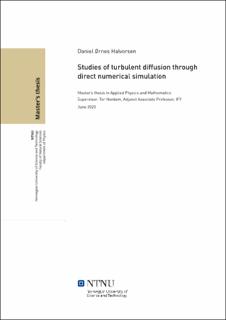| dc.contributor.advisor | Nordam, Tor | |
| dc.contributor.author | Halvorsen, Daniel Ørnes | |
| dc.date.accessioned | 2021-09-28T18:35:44Z | |
| dc.date.available | 2021-09-28T18:35:44Z | |
| dc.date.issued | 2020 | |
| dc.identifier | no.ntnu:inspera:57076746:31408159 | |
| dc.identifier.uri | https://hdl.handle.net/11250/2785525 | |
| dc.description.abstract | I denne mastergraden ble en tredimensjonal løser for direkte numerisk simulasjon implementert ved
bruk av en spektralmetode, og parallellisert ved bruk av en penn-dekomposisjon, med hensikt å studere den superdiffusive oppførselen til turbulente strømningsfelt. Transport i turbulente strømningsfelt ble studert ved bruk av to ulike metoder; en stokastisk partikkel modell og adveksjons-diffusjons likningen. Partikkelmodellen ble parallellisert direkte ved å spre partiklene mellom prosessorer, og adveksjons-diffusjons likningen ble parallellisert ved bruk av en plan-dekomposisjon. De numeriske implementasjonene ble kjørt på superdatamaskinene Idun og Vilje, begge lokalisert ved NTNU i Trondheim. To simuleringer ble kjørt. Den kalkulerte variansen til partikkelposisjonene bekreftet den superdiffusive oppførselen til turbulente strømninger i den første kjøringen siden variansen skalerte med tiden opphøyd i 2.54 . I den andre simuleringen indikerte den kalkulerte variansen av partikkelposisjonene og den numeriske løsningen til adveksjons-diffusjons likningen en mer lineær skalering. Konklusjonen er at flere simuleringer må kjøres for å danne statistisk konfidens på skaleringen av den turbulente diffusjonen. | |
| dc.description.abstract | In this thesis a three-dimensional solver for direct numerical simulation was implemented using a spectral method, and parallelized using a pencil decomposition, to study the superdiffusive nature of turbulent flow fields. Transport in turbulent flow fields were studied using two different methods; a stochastic particle model and the advection-diffusion equation. The particle model was parallelized directly by scattering the particles amongst computer cores, and the advection-diffusion equation was parallelized using a slab decomposition. The numerical implementations were run on the high-performance computers Idun and Vilje, both located at NTNU in Trondheim. Two simulations were run. The computed variance of the particle positions verifies the superdiffusive nature of turbulent flows in the first simulation as the variance scales with time to the power of 2.54. In the second simulation the computed variance of the particle positions and the numerical solution to the advection-diffusion equation indicates a more linear scaling. The conclusion is that more simulations must be run to achieve a statistical confidence on the scaling of the turbulent diffusion. | |
| dc.language | | |
| dc.publisher | NTNU | |
| dc.title | Studies of turbulent diffusion through direct numerical simulation | |
| dc.type | Master thesis | |
